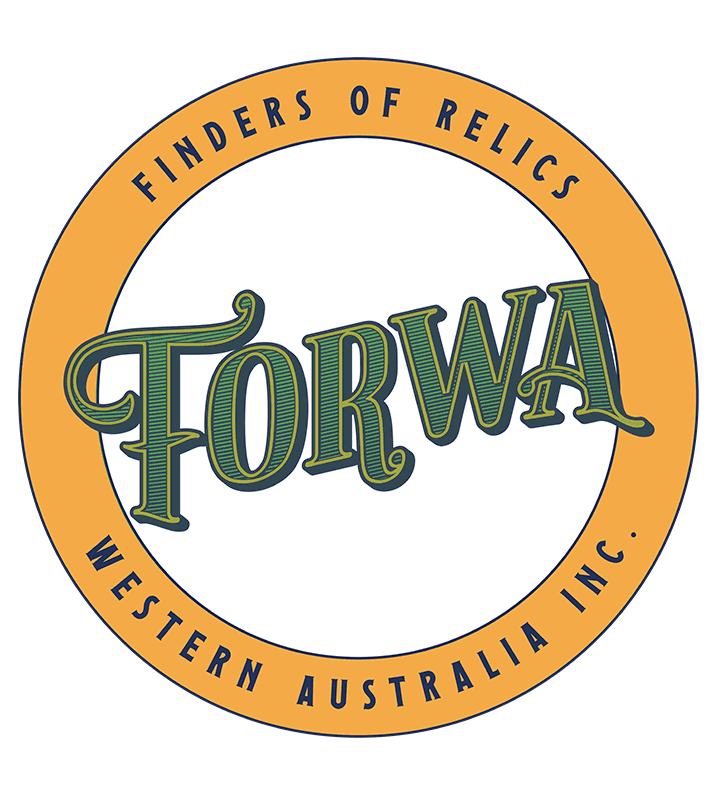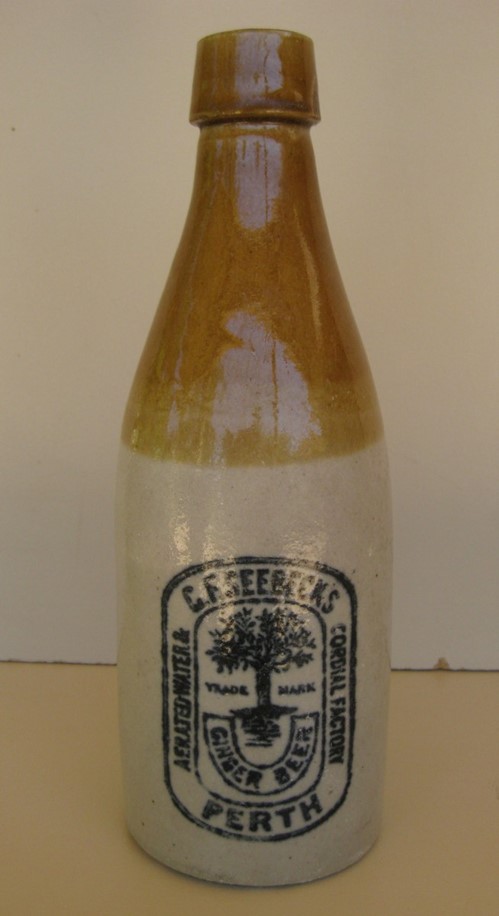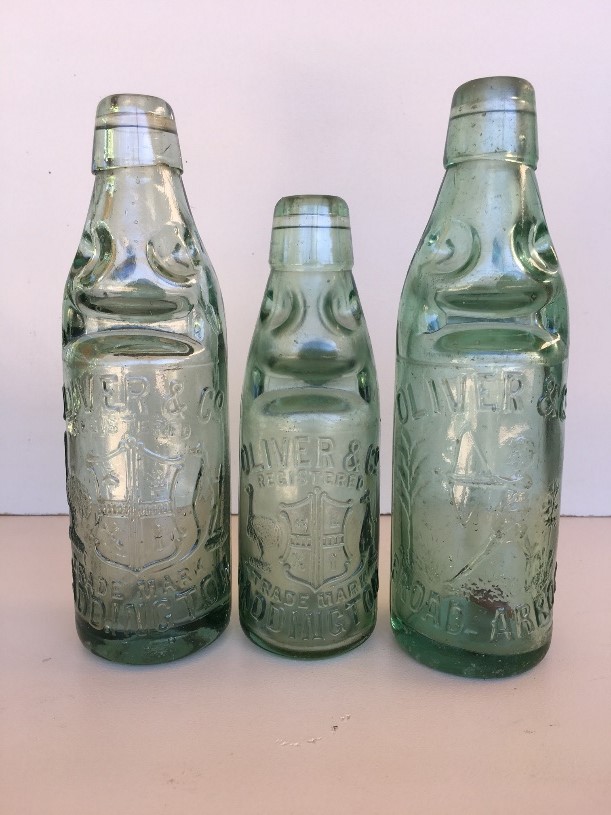Johann Heinrich Seebeck was a German immigrant who made his way to Australia in the mid 1800’s. His Prussian born wife Johanna Charlotte Schmidt arrived in Adelaide as an infant in 1850. Three of their seven children came to Western Australia c1894 to the Coolgardie goldfields.
Eldest son John Valentine Seebeck was born at Chewton, Victoria in 1864. He arrived in the West with his younger brother Gustave Frederick Seebeck born in 1866, his sister Frances Frederica, wife of Kunibert Zabel & Gomer Oliver born 1869, whose sister Emily Oliver born Echuca Victoria in 1871 was the wife of Gustave Seebeck.
Many Victorians arrived to make their fortunes although most found the harsh inland conditions and lack of fresh water very difficult, but some pioneers of those early towns persevered until the gold dwindled.
GUSTAVE FREDERICK SEEBECK was born in 1866 and had spent his early life around Chewton where his father was a store keeper and at Castlemaine. He enjoyed the past times of weight lifting, hammer throwing and cable tossing whilst becoming a saw miller around Echuca.
He married former school teacher Emily Oliver in 1891 and then moved to Coolgardie where he became a partner in the Pioneer Aerated Water Company in Sylvester St, Coolgardie with Otto Heiderpreim and his brother in law Kunibert Zabel.
On the 11 April 1895 the partnership was dissolved when Seebeck moved his family to Kanowna. Heiderpreim and Zabel continued with the Pioneer Aerated water factory until 19 February 1898.
Kanowna was 18 kilometres N E of Kalgoorlie on the Kurnalpi Rd. The goldmine was known as White Feather & the miners wanted the townsite to bear this name but the Government named it Kanowna after the aboriginal name for the area. The townsite was gazetted on 14 December 1894.
SEEBECK erected a steam saw mill here with his partner CONRAD LONG, at a cost of 2,000 pound. The town was expanding and a mill to supply timber for housing and the mines was a good investment. They attached an Aerated Water Factory to the building and in February 1896 supplied the town with various cordials. However, disaster struck in March, when 1 ½ inches of rain fell in 20 minutes at 4pm in the afternoon. Hail as large as pigeon eggs pelted the buildings and many lost rooves and Long & Seebeck’s aerated water factory was blown off its foundations. In 1897 Seebeck was the Mill and Yard manager and Long was the Hardware manager.
In November 1896 the first boat built in the goldfields by Gibson, Richardson and Webster was made for Long & Seebeck. Did they expect another deluge like the one in March?
In 1897 Long & Seebeck registered the town name of Kanowna on their glass bottles. They had a feather on their Codd bottles, some feathers facing to the right and some to the left. There was also a small feather on the White Feather bottle. Was this the earliest bottle of the company with the White feather name still in use.
Even though the partnership was on going, Seebeck had moved to Perth by mid 1897. He registered the “Tree” trade mark on 24 August 1897 for mineral and aerated waters both natural & artificial including ginger beer and non – fermented Liquours, and gave his address as Hutt St, Perth. Other trade mark registrations in 1897 for Gustave Seebeck and Company included “Westralia” for French Champagne, “Rimatara” for cordial and “Tasmanian” for ale.
In May 1898 he is in William Street, Perth and advertised for a girl to label bottles.
Long and Seebeck dissolved their partnership as timber merchants and aerated water manufacturers of Kanowna on 14 February 1899 and Long continued in business in the town.
Seebeck’s unsettled circumstances saw his wife journey back to Victoria for the birth of her 5th child the same year (1899) and in November, Wood & Co were instructed to sell his William Street premises in Perth which he had bought 2 ½ years previously. The plant could produce 250 dozen bottles of aerated waters per day, besides Hop & Ginger Beer and Vinegar. All the usual plant machinery plus casks, hogsheads, boxes, bottles, syphons, labels etc were included in the sale.
In late March 1899 Seebeck set up a cordial factory in Brown Street, Menzies. He purchased land formerly occupied by Mr Sadler the local plumber and it took six weeks before he was satisfied the plant he had bought over from Kanowna, was ready for drinks to be sold to the community. Ads appeared in the newspapers until 14 July 1899.
In 1901 Claremont Mineral Springs had purchased the rights to the bottles branded G F Seebeck in Perth & would pay for the return of these bottles delivered to their premises.
Seebecks wife returned and in September 1903 the family moved to Pinjarra in the south west where he joined the coach building, blacksmith and wheelwrights firm of McNab & Richer. They erected an aerated water factory alongside their building near Pinjarra railway station where Seebeck produced lemonade and soda water. However, 6 months later McNab & Richer retired and the coach building works & aerated water plant was for sale. Also included were 20 gross patent bottles and a quantity of cordials.
He moved back to his trade of saw milling when he joined Jack Lyall’s mill at Lyallville near Collie as the manager towards the end of 1903.
Around late 1905 he returned to Victoria with his family and resumed saw milling here and poultry farming. He was the father of 12 children and died at the home of his son at Springvale in 1938.
In the Obituary of Gustave Seebeck, the family mentioned that on arriving in the West he shipped horse teams to the state and began transporting goods with horses and camels between Southern Cross and Coolgardie. However, I did not find any information in the newspapers of this enterprise. Also, of his success in the hardware trade. He managed to secure the Royal Exchange Hotel at Kanowna and White Feather Brewery. The White Feather Castle brewery did have shareholders, he may have been one of them, plus Long had the Royal Exchange Hotel when he filed for bankruptcy in 1907. Long and Seebeck’s association may have extended long after they dissolved their partnership of the aerated water factory in 1899.
Seebecks wife Emily died in 1925 at Northcote, Victoria.
CONRAD LONG. He was born in 1858 at Emerald Hill, Victoria. He was the son of Christopher Long and wife Catherine nee Daiters and married Minna Emma Stammers in Victoria. He was a friend of the Seebeck family and proprietor of a drapery store at Woodend in the 1880’s. In 1890 this was put in the hands of a trustee to pay his creditors. He was also the secretary of the Woodend Athletic club and secretary of the Volunteer Corps. In 1894 he was a partner with John Henry Seebeck in a sawmill at Woodend.
He made his way to Kanowna after his business collapsed and joined Gustave Seebeck in his aerated water enterprise. After he and Gustave Seebeck dissolved their partnership, he took an interest in the Australia Hotel at Kanowna with William Johnson Holmes and Wilson Dunn. This partnership was dissolved on 22 Nov 1900 when Long retired from the business.
He was very interested in Civic affairs and became the Mayor of Kanowna, a position he held for 3 years until 1903. He put forward the idea of a water tower for the town in 1903 to reticulate the township. This was completed, but his reputation suffered as it was referred to as a white elephant because the Government took too long to extend the water pipeline from Kalgoorlie.
By 1906 Long was once again in difficulty with his business. He may have over extended his involvement with the township of Kanowna. The bankruptcy proceedings in August 1906 for Conrad Long & Co trading as storekeepers at Town Lots 52, 53 & 54 of shops and dwellings some unoccupied and stables in Isabella Street and Town Lots 71 & 72 with dwellings, stock in trade, general hardware, boots, timber, glass plant etc were to be offered for sale in January 1907. His Town Lot 71 and 72 had a frontage to Nemesis St and on the south to Moore st and was used as a saw mill and a large iron building used as an aerated water factory. This was let at 3 pound a month to Arthur Whitworth on a tenancy of 1 months notice. There was also a 4 roomed weatherboard house and iron office. In February 1907 his half interest in the Royal Exchange Hotel with 4 shops on Town Lot 27 was also added to his bankruptcy list.
By 1911 Long had moved to Leederville and also spent time at Gingin and Mount Street in Perth. In 1919 he gave his occupation as agent. He died at Gingin in 1922 aged 64 years. He left a widow and 2 sons and 2 daughters. One son pre deceased his father in 1913. His wife Minna Emma Long died in Perth in 1944.
ARTHUR WHITWORTH. I will briefly mention his time at Kanowna. He was a baker and born in 1866. He dissolved his partnership with John Muller as a baker here in 1900 and Muller continued the business. He was then producing aerated waters in Longs factory. By 1912 he took over the licence of the Commercial Hotel at Kanowna from Timothy Creed but still worked the cordial factory until 1915 when pastoralist Joseph Thomas Ruttle who had bought the factory building from Long, issued a writ claiming non payment of rent from October 1912 till March 1914. However, Whitworth believed he had an agreement for free rent so the business could be sold as a going concern. He moved from Kanowna to Point Peron where he died here after collapsing while riding his bicycle on Rockingham Rd aged 78 years on 9 March 1944. His wife Lily May Whitworth died in South Australia in 1964.
JOHN VALENTINE SEEBECK. He was born in 1864 in Victoria and married Mary Anne Mace at Broad Arrow in 1897.
BROAD ARROW is 38 kilometres north of Kalgoorlie on the road to Menzies. The town was gazetted as Broad Arrow on 18 September 1896. In 1896 the town had 2,000 residents and by 26 February 1897 it had the status of a Municipality. Among the many buildings were 8 hotels and 2 breweries.
John V Seebeck and partner GOMER OLIVER had the Oliver & Seebeck aerated water factory at Paddington & Broad Arrow. The Broad Arrow factory was on Town Lot 43 in MacDonald Street and the lease was granted on 28 July 1897. However, they were already producing aerated waters here under the name Oliver & Co and employed a well known cordial maker Kenneth Fraser from Charters Towers in Queensland in December 1896. In September 1897 they sought permission of the Council to erect a temporary bough shelter for protection, for bottle washing.
Seebeck became a Councillor in 1898 and provided drinks to a school sports day. Their speciality being Hop and Ginger Beers. They dissolved their partnership on 12 June 1900 when Seebeck moved on and Oliver became the sole proprietor.
PADDINGTON is on the main road to Menzies and 30 kilometres north west of Kalgoorlie. The town was gazetted on 5 February 1897. The name was changed to Gudarra on 14 June 1912 because of the confusion with Paddington in the eastern states but the town was always referred to as Paddington.
The Paddington factory lease was granted to Town Lot 26, Mona Street on 6 February 1900 but Seebeck and Oliver’s address was listed as Broad Arrow.
The factory had a Haywood Tyler improved machine, 2 Dan Rylands Patent Turn over racks and bottling racks, plus syphon racks and driven by a 2 ½ HP motor. The partnership agreement was dissolved for this premises on the same day as the Broad Arrow business in 1900.
Seebeck returned to Victoria where he died at his residence “Sylvia” in Bayswater, Victoria in 1904. His wife Mary Anne remarried in 1907 to Henry Pakes.
GOMER OLIVER. He was born at Moana NSW in 1869 and was also in the timber industry. He was a champion axeman and also on the Broad Arrow Council.
He married Hannah O’Hea in Perth in 1900. He also acquired Town Lot 56 in Mona Street, Paddington on 23 March 1900. He was John Valentine Seebeck’s partner.
Oliver became the sole proprietor of the Broad Arrow Aerated Water Factory on 12 June 1900 and also took over the Paddington aerated water factory on the same date. On 12 April 1913 at Broad Arrow, all equipment including 100 dozen Patent bottles, 30 dozen Patent cordial splits, a quantity of stone ginger beer bottles, soda syphons and a 5 roomed house at Paddington were listed for auction. He returned to the area of Kanyapella near Echuca in Victoria and went farming. He died in 1936 and is buried at Echuca. He was the father of seven children and his wife Hannah Oliver died in 1940 and is also buried in Echuca.
Oliver & Co marble bottles have both Broad Arrow and Paddington trademarks and the large Paddington bottle features a coat of arms. The Broad Arrow bottle has a man with a bow.
Author – Vivienne Sinclair.






